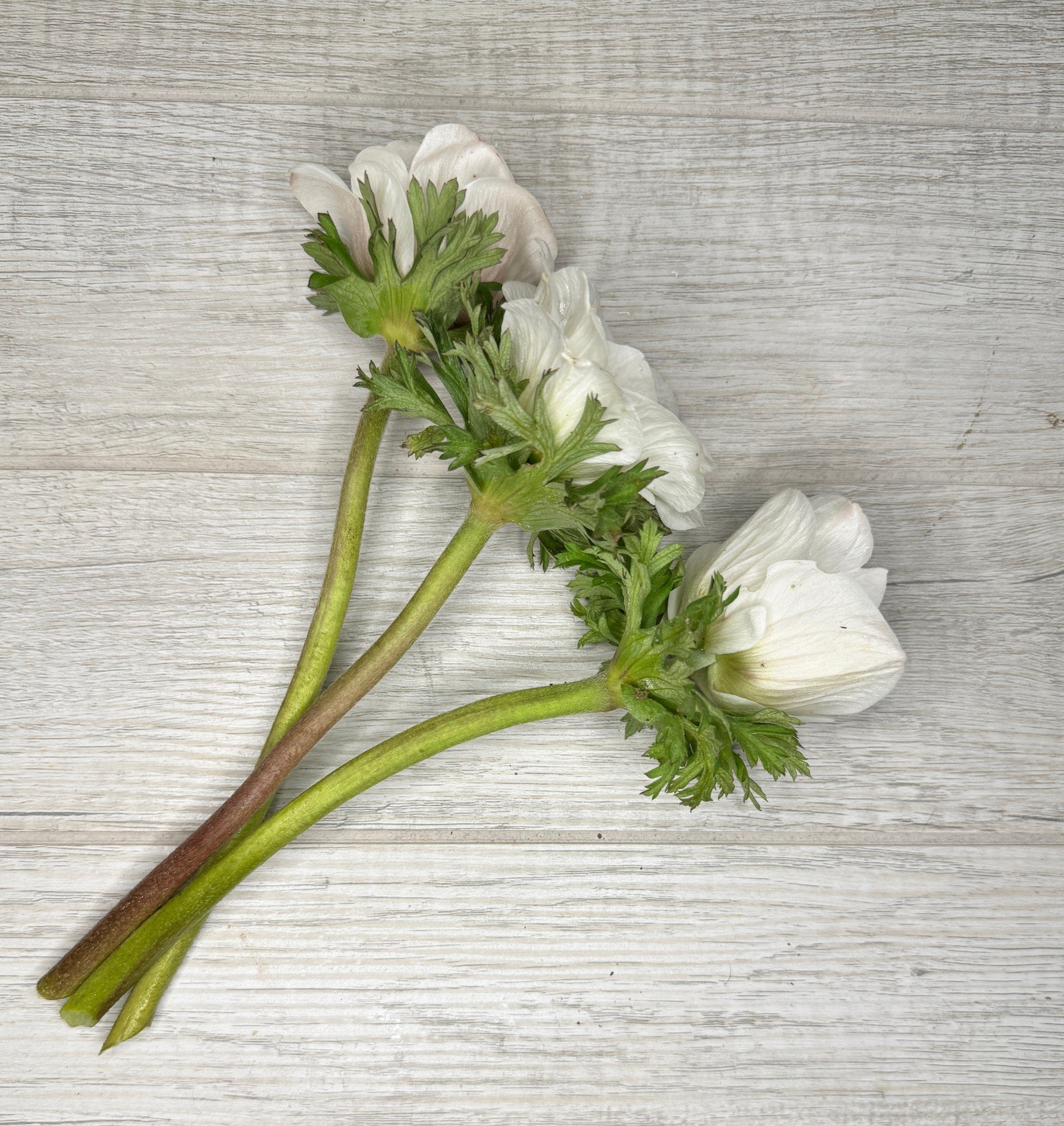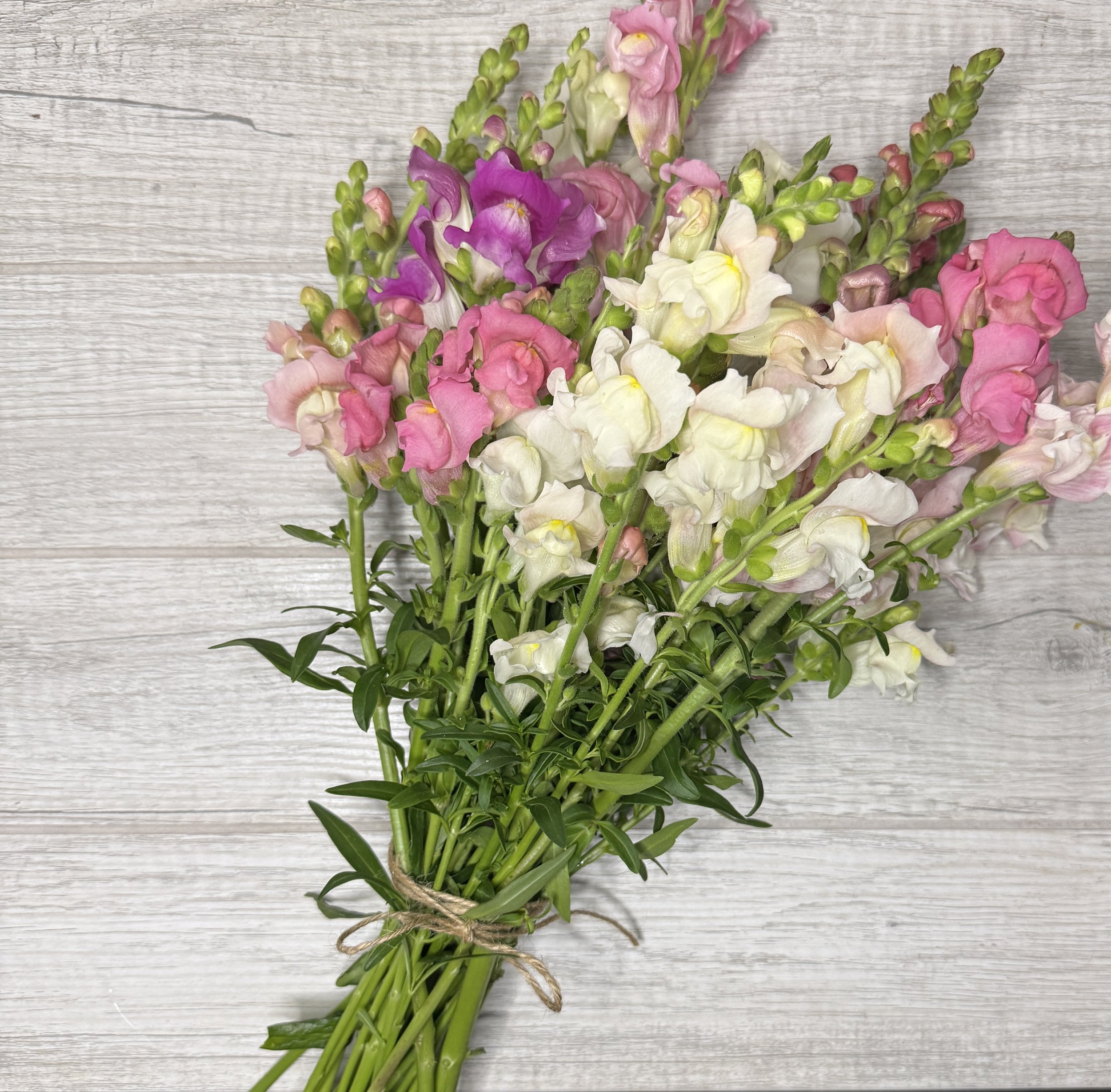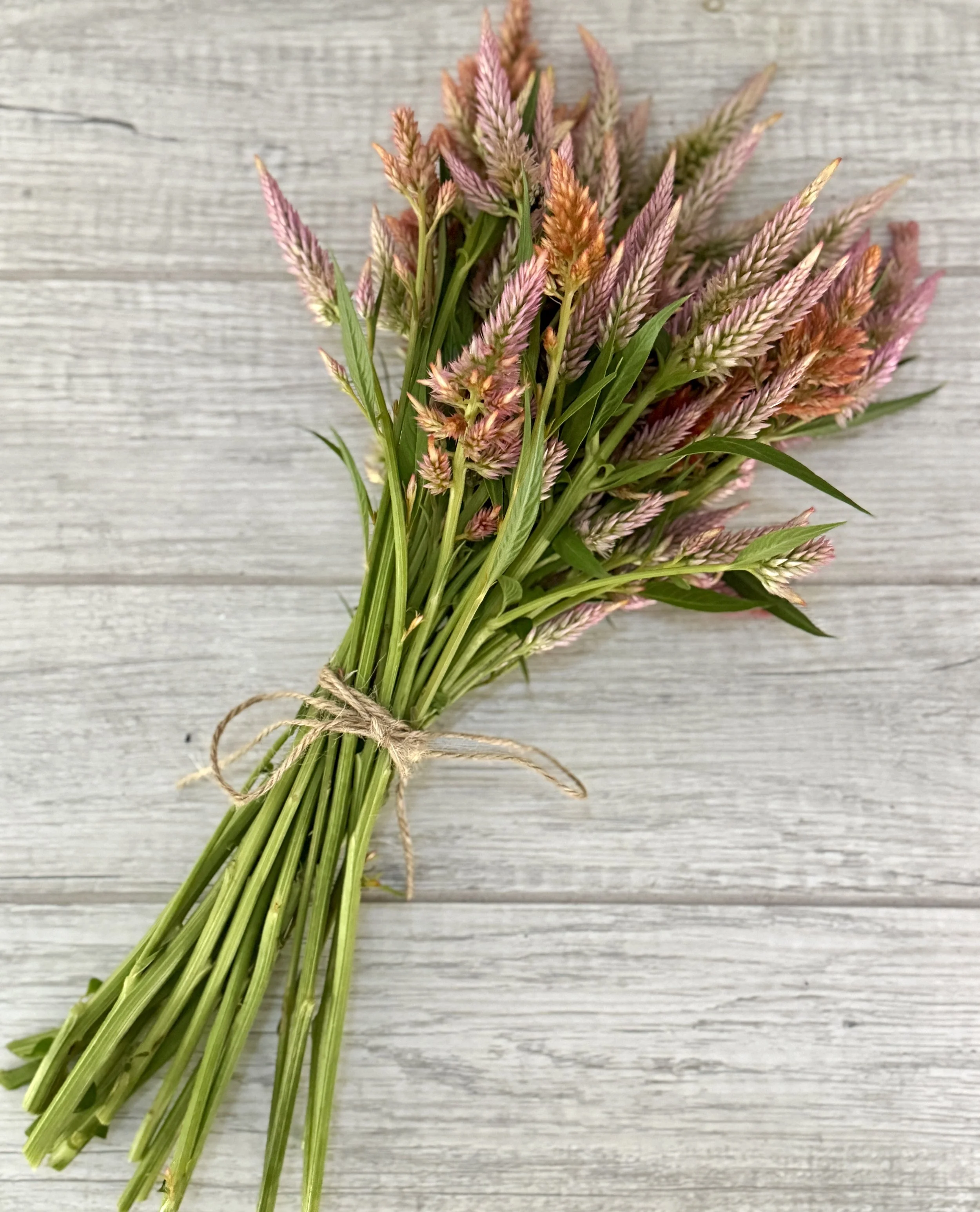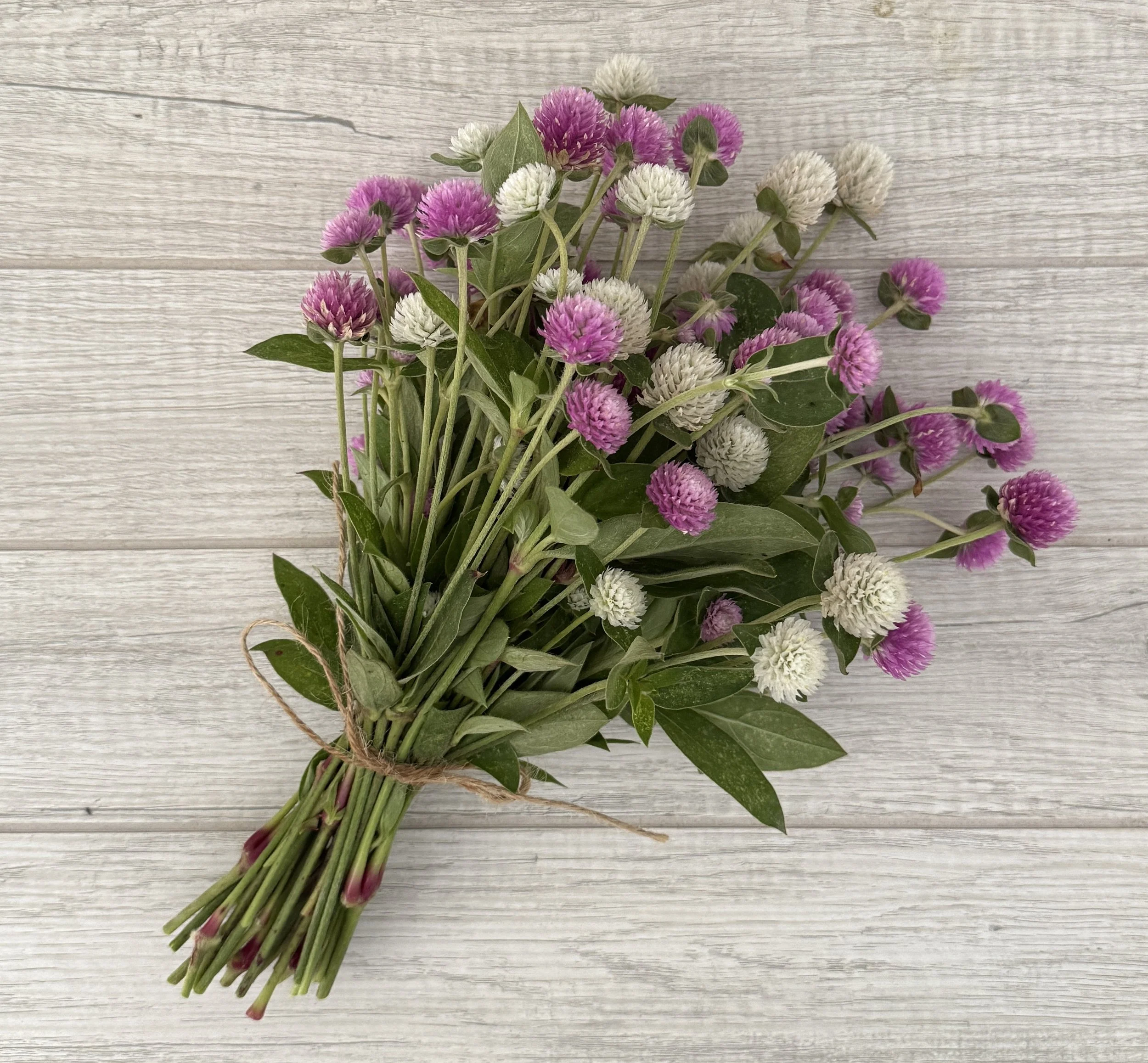
THE FLOWERS WE GROW
Below are some of the flowers that we grow and the approximate bloom times for our flowers.
-

Tulip
-

Ranunculus
-

Daffodil
-

Anenome
-

Calla Lily
-

Dahlia
-

Sunflower
-

Calendula
-

Stock
-

Peony
-

Snapdragon
-

Sweet Pea
-

Allium
-

Lily
-

Lisianthus
-

Rudbeckia
-

Echinacea
-

Zinnia
-

Poppy
-

Celosia
-

Gomphrena
-

Carnation
-

Aster
-

Clarkia
Early April - Mid May
-
Tulip flowers are usually large, showy, and brightly colored.
They follow the sun even when they’re in a vase. That’s why you should move them around your home during different times of the day.
Tulips continue to grow after they’ve been cut
-
Daffodils are spring-flowering perennials characterized by their trumpet or cup-shaped centers.
The most recognized daffodil is the dutch yellow daffodil but daffodils come in other colors such as white and light orange.
-
Ranunculus are loosely clustered, cup-shaped flowers have tissue-thin petals and they come in colors that range from cream and pale yellow to apricot, pink, orange, red and burgundy.
-
Poppies have paper-like blossoms and vibrant colors.
-
Anemones grow from a tuber and depending on the type, will bloom in either spring, summer or fall. The cup-shaped flowers come in various colors of red, pink, blue, yellow, purple and white
Late June - Mid July
-
-
Peonies bloom late spring and early summer, they produce large single and double flowers of white, pink, rose, and deep crimson color.
-
Snapdragons come in a variety of colors. The leaves are usually lance-shaped. The flowers are tubular, bilaterally symmetrical, and usually large with a closed liplike mouth that excludes most insects but can be forced open by strong bees, the main pollinators
-
Lisianthus plants are about 1 to 3 feet tall, featuring large purple and white bell-shaped flowers with flaring lobes that bloom on one or more upright stems.
-
China Asters display a showy, 3-5-inch diameter blooms from early summer to fall. Appearance ranges from single daisy-like flower heads with yellow centers to fully double flower heads with shaggy to pompom form.
-
The distinctive calla lily flower comes in many beautiful colors, including classic white (a favorite), yellow, orange, pink, rose, lavender and dark maroon.
Mid - Late May
-
Sweet peas have a short vase life but are grown mainly for their abundant fragrance. They come in a variety of colors and are grown as a vine.
-
Snapdragons come in a variety of colors. The leaves are usually lance-shaped. The flowers are tubular, bilaterally symmetrical, and usually large with a closed liplike mouth that excludes most insects but can be forced open by strong bees, the main pollinators
-
Tulip flowers are usually large, showy, and brightly colored.
They follow the sun even when they’re in a vase. That’s why you should move them around your home during different times of the day.
Tulips continue to grow after they’ve been cut
-
Ranunculus are loosely clustered, cup-shaped flowers have tissue-thin petals and they come in colors that range from cream and pale yellow to apricot, pink, orange, red and burgundy.
-
Alliums grow to 4 or 5 feet tall with white, blue, lavender or purple snowball-shaped inflorescences atop bare stems.
-
Anemones grow from a tuber and depending on the type, will bloom in either spring, summer or fall. The cup-shaped flowers come in various colors of red, pink, blue, yellow, purple and white
Mid July - Late August
-
The common sunflower has a green erect stem covered in coarse hairs, growing on average around 5 foot tall. The 'flower' of the common sunflower is actually a pseudanthium, or flowerhead, made up of many small flowers.
-
The Dahlia flowers are incredibly diverse, with colors including white, yellow, orange, red and purple of varying shades.
-
Rudbeckia is a coarse plant that features daisy-like flowers (to 3” across) with bright yellow to orange-yellow rays and domed, dark chocolate-brown center disks. Blooms throughout the summer.
-
Echinacea has tall stems, bears single pink or purple flowers, and has a central cone that is usually purple or brown in color. The large cone is actually a seed head with sharp spines that resemble a stiff comb.
-
Gomphrena, also known as globe amaranth, is a delightful flowering annual grown for the petite globe-shaped blooms that can be enjoyed fresh or as dried flowers. There are pink, red, orange, purple and white gomphrena varieties.
-
Zinnias have stiff, hairy stems and oval or lance-shaped leaves arranged opposite each other and often clasping the stem. The numerous garden varieties grown for their showy flowers and variety of bright colors.
Early - Mid June
-
Peonies bloom late spring and early summer, they produce large single and double flowers of white, pink, rose, and deep crimson color.
-
The stock flower, with its sweet, heady-scented blooms, are typically found in white, pink, red or lilac, stock is also called gillyflower or Virginia stock.
-
Sweet peas have a short vase life but are grown mainly for their abundant fragrance. They come in a variety of colors and are grown as a vine.
-
Asiatic lily flowers are upright-facing, six-pointed blooms that come in a variety of bright colors. They often have spots on the inner portion of their petals and stamens that might have a contrasting color.
-
The distinctive calla lily flower comes in many beautiful colors, including classic white (a favorite), yellow, orange, pink, rose, lavender and dark maroon.
Early September - Mid October
-
Rudbeckia is a coarse plant that features daisy-like flowers (to 3” across) with bright yellow to orange-yellow rays and domed, dark chocolate-brown center disks. Blooms throughout the summer.
-
The common sunflower has a green erect stem covered in coarse hairs, growing on average around 5 foot tall. The 'flower' of the common sunflower is actually a pseudanthium, or flowerhead, made up of many small flowers.
-
Zinnias have stiff, hairy stems and oval or lance-shaped leaves arranged opposite each other and often clasping the stem. The numerous garden varieties grown for their showy flowers and variety of bright colors.
-
The Dahlia flowers are incredibly diverse, with colors including white, yellow, orange, red and purple of varying shades.
-
The name "chrysanthemum" is derived from ancient Greek for the words gold and flower. The plants can grow 2-4 feet tall with blooms that are white, yellow, or pink.
-
Echinacea has tall stems, bears single pink or purple flowers, and has a central cone that is usually purple or brown in color. The large cone is actually a seed head with sharp spines that resemble a stiff comb.
